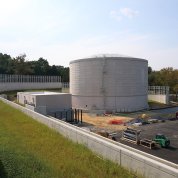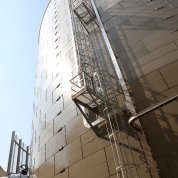Water Tanks Fill to Serve Campus Needs

Photo: Chia-Chi Charlie Chang
Since most NIH’ers are never going to go back there, let’s talk a little about the two giant water tanks recently constructed on the south side of campus.
The one closest to the south border is called the Industrial Water Supply System, or IWSS. It exists primarily to provide the campus Central Utility Plant (CUP) with about 4 days of water in the event of an emergency. It holds 5 million gallons; daily water use at the CUP averages 1.2 million gallons.
It offers insurance, given that the local water authority has many old pipes that occasionally rupture. A major break several years ago once threatened campus safety. The IWSS will also provide makeup water to the utility plant chillers, cooling towers and boilers during a regional outage.
The tank’s principal feature is a massive retaining wall separating the IWSS from parking lot 41. Just below the wall is a new surface parking lot—lot 42—with space for some 250 cars. One day, a multi-level garage is projected to rise from the plateau. The IWSS is due to come online late this year.
The larger and more complicated tank—the Thermal Energy Supply System, or TESS—is basically a thermos, said Dr. Farhad Memarzadeh, director of the Division of Technical Resources (DTR), Office of Research Facilities.
Topping out at 8 million gallons, the TESS stores chilled water manufactured by 12 massive chillers at the CUP across the street. The idea is that you fill it up with cold water at night, when electrical costs are low (due to lower night-time power demand) and discharge it during the day. The TESS began operations on Aug. 6.
Both tanks are abutted by small unoccupied pump houses that are operated remotely. Each features power vaults, to run the electric pumps, and the pumps themselves. The enclosures are pleasantly air-conditioned, because even electrical equipment prefers to stay cool in summer’s heat.
Fun facts:
- The water in the IWSS is treated to prevent bacterial growth that would foul pipes and valves. DTR also weekly tests for planktonic microbial population and monthly checks for Legionella in its chilled water cooling towers.
- It takes about 4 days to fill the IWSS. The TESS can fill in anywhere from 8 to 18 hours, depending on the flow rate.
- Remote-controlled robots can patrol either tank, if needed, to search for flaws, “just like an undersea robot,” said Dr. Abdul Bhuiyan, chief of DTR’s Utility Systems Design and Technical Service Branch.
- The CUP is one of the largest central utility plants in the country. Over 34 million data points are collected and analyzed daily using 1 million advanced calculations from about 5,000 continuously running analyses. This compares with only 480 data points recorded manually in 2013. As Memarzadeh says, “We can’t manage what we can’t measure and we can’t make improvements without data.”
- From the time DTR began managing the CUP in FY 2014 to the present, cost of energy and water has been reduced by over $50 million to date despite cooler winters and hotter summers.
- Memarzadeh says CUP uses a highly advanced mathematical modeling-based artificial neuron network in conjunction with time series forecasting using Holt-Winters exponential smoothing and machine-learning to weave such factors as 96-hour heating and cooling load and commodity prices. Based on the results of these models, DTR establishes a specific procurement plan for natural gas.
- Memarzadeh, who has been at NIH for 27 years, notes that his division’s Design Requirements Manual (DRM) for biomedical laboratories and animal research facilities—available on the ORF website and translated in many languages—gets one of the most internet hits at NIH. The 1,000-page DRM is the only detailed design requirements and guidance manual of its kind. In order to provide guidance and standards that represent the best practices in facility design, DTR assembled more than 200 professionals from industry, academia and government to help with this manual.
“It’s basically the guideline for the rest of the world, even though we are not a regulatory agency,” observes Brad Moss of ORS/ORF communications.
Although landscaping around each of the tanks is not yet complete, plantings are anticipated to “soften the hardscape” sometime this fall, said Allan Buller-Jarrett, project officer in DTR who works on the IWSS.
Both tanks are also clad in ornamental pre-cast concrete with natural stone accents. “With a modest incremental investment,” said Memarzadeh, “we have made these not only very functional, but [also] aesthetically pleasing so that they complement the beauty of our campus.”










